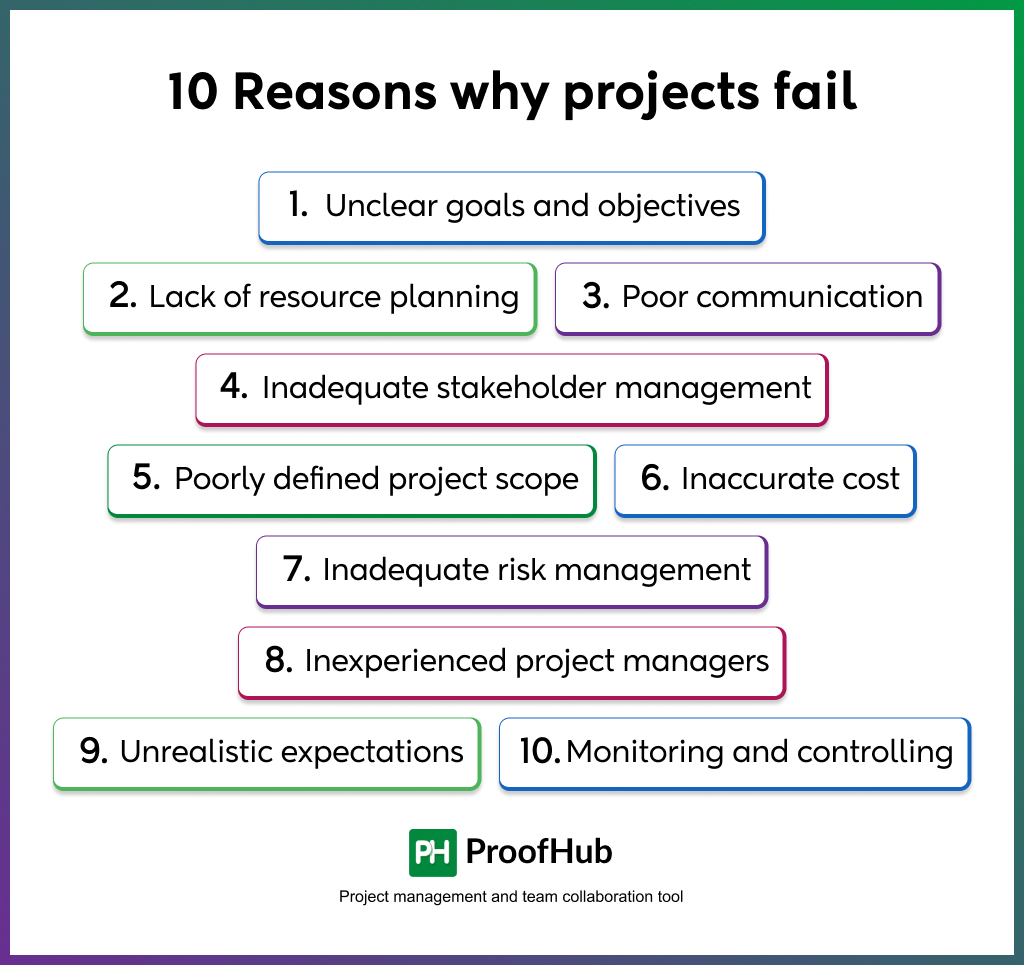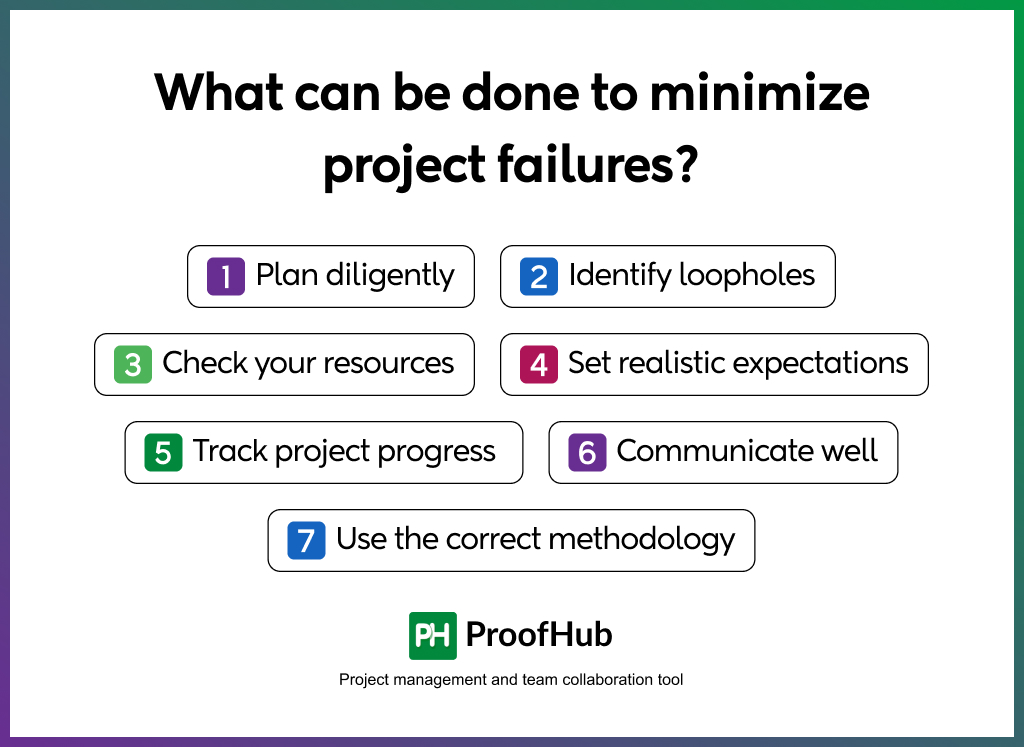Project failures are often caused by missed deadlines, dissatisfied managers and clients, and deliverables that fall short of expectations. Understanding the reasons why projects fail is crucial to improving project outcomes.
Even if we start off quite motivated and focused, there are moments when we overlook crucial details that could lead the project to fail.
Project failure can occur for various reasons, such as poor planning or an unmanageably large project scope. Discover 10 common reasons why projects fail and how to avoid them.
A Free guide to help you with proven ways to lead a project from start to finish, without confusion or jargon.

10 Reasons why projects fail & their solutions
Here are ten reasons we’ve discovered to persist in poorly run or unsuccessful projects.

1. Unclear goals and objectives
Many projects fail due to unclear project objectives and milestones.
How can you expect your project to succeed when you do not set clear goals and objectives for your team? At ProofHub, this is the first and essential step whenever we have a new project in our hands.
Unfortunately, not all teams follow suit.
Businesses that fail to set out clear goals and objectives for employees waste a significant chunk of their time and efforts. Following are the effects of vague project goals and objectives.
- Unclear objectives lead to unclear operational methods
- The quality of performance can be justified on an individual basis
- One does not realize when the project veers off the track until the last moment
- People involved in a project cannot perform with maximum effectiveness
2. Lack of resource planning
Resources in project management refer to men, money, and materials. What are you supposed to do without adequate resource planning for project management?
If you’re not using a good task management tool, then it’s likely that your human resources are either being under-utilized or overworked.
You’ll fail to notice that some of your team members are working on too few tasks while others are working on too many tasks simultaneously (remember the side-effects of multitasking?).
Financial planning is another important aspect of project resource planning. Projects with poor cost estimations and irregular tracking will likely surpass their original budget.
Project managers who don’t know how to track and manage finances are likely to push the project to failure.
3. Poor communication across the organization
Poor communication is a major factor in project failures. Teams that face communication delays, or the lack of it, will experience trust and transparency issues.
The main reasons for communication failures across organizations can be attributed to:
- Absence of communication policy
- Lack of stakeholder engagement
- Lack of mutual understanding among employees
- Project managers assume that communication has taken place when it doesn’t
Poor communication within the workplace can have devastating effects on the project in the form of poor collaboration, loss of productivity, stressed employees, unhappy customers, and mistrust in the workplace.
Whether it’s delayed communication, lack of communication, or no communication at all, the fact is that without an effective communication strategy, your project is likely to fall through the cracks.
4. Inadequate stakeholder management
Stakeholders have an inherent interest in the project, either for good or bad.
Project managers are responsible for identifying all stakeholders and communicating with them on time, without any delays. Not doing so can increase the likelihood of project failure.
There are many reasons for poor stakeholder management; some of the most common ones are mentioned below.
- Defining stakeholders too narrowly.
- Failure to maintain a balance between compliance and strategic opportunities.
- The tendency of company executives to get defensive too quickly in the face of negative comments.
- Hiding self-interest.
- Stakeholders are taking away resources prematurely.
- Lack of interest from stakeholders.
- Stakeholders are unaware of the project’s progress.
Engaged stakeholders offer support and insights to drive your projects toward success, but disengaged stakeholders may become barriers to success.
5. Poorly defined project scope
The project scope outlines everything you’re going to do (and not going to do). Scope creep in project management refers to uncontrolled, continuous changes in a project’s scope.
Generally, a poorly defined project scope results in scope creep, where the former is vaguely defined, documented, or controlled.
Scope creep is seen as a negative occurrence that should be avoided. A project with a poorly defined project scope has more chances of failing and experiencing a range of problems, like:
- Failing to meet client expectations.
- Continuous changes are being requested throughout the project course.
- Major changes are required during the project life cycle.
- The budget goes beyond the allocated budget.
- Failing to adhere to deadlines.
Poorly defined project scope invariably results in poor employee performance, poor client accountability, longer timelines, and higher project costs.
6. Inaccurate cost and time estimates
Inaccurate cost and time estimates are often the vague guesses of team members who calculate the expected duration of tasks and the project’s cost based on an average duration of time and cost it took for previous projects.
While this method of calculating estimated task duration and cost may turn out to be accurate, it can also lead to completely inaccurate estimates.
This can cause all sorts of trouble for employees who are assigned tasks and asked to complete those according to estimated times.
When tasks aren’t completed in line with the estimated time, employees have to face the ire of the senior management for no apparent fault of theirs.
Inaccurate estimates are often the result of two underlying causes:
- Upfront planning.
- Poor estimation practices.
7. Inadequate risk management
Risk management enables project managers to detect and analyze concerns that may arise during the project and hinder its progress.
If you are not managing risks effectively, there is a good chance that they might appear during the later stages of the project and cause major scope creep.
Poor risk management can delay the project schedule, poor user adoption, late-running projects, overspent budgets, and project failure. It’s a fact that no project goes perfectly, and things can go wrong.
Projects have a certain degree of uncertainty about them, and having a risk management plan can lower the uncertainty, besides increasing the likelihood of completing your project on time.
Read more – Best risk management software to mitigate risk
8. Inexperienced project managers
How can you expect a rookie project manager to take charge and ensure your project is executed and delivered successfully?
No way I am saying that new project managers don’t have it in them, but it’s just that their inexperience in handling projects does increase the likelihood of project failure as compared to a seasoned and resourceful manager.
And then, some organizations don’t take project management seriously and think that anyone can manage a project. As a result of this lackadaisical approach, many assistants or consultants are made accidental project managers without any credentials to their name.
They might be excellent in their discipline, but if they have less experience in project management, they can be one of the main reasons for your project’s failure.
9. Unrealistic expectations
Regarding project management, it’s not expectations but unrealistic goals and objectives that can spell doomsday for projects.
Often disguised as optimism, unrealistic expectations have caused the downfall of many projects. This situation occurs when project managers fail to analyze (accurately) every team member’s strengths, skills, and competencies.
As a result, employees are overburdened with tasks that they might find difficult to complete in time.
You should know what your team can do and in what time frame. Your expectations should be realistic, i.e. they should sync with your team’s capabilities.
10. Monitoring and controlling
Monitoring and controlling the project is perhaps one of the less understood facts that project managers and their teams do not pay adequate attention to.
You don’t need to be a rocket scientist to figure out that you should “track, review, and regulate the progress of the project; identify areas that call for changes in the planning, and initiate the corresponding changes.”
Every attempt should be made to ensure that the project stays on track, and when it falls behind budget or schedule, the plan should be changed to get the project back on track.
Many project managers create a schedule only, never updating it. Even if they update a schedule, it is just to fill in the percentage, which is an erratic figure often picked out of nowhere by the team members.
What can be done to minimize project failures?
Even the darkest of clouds has its silver lining. While failures are part and parcel of project management, you can always learn from your mistakes to succeed in the future.
The key to success in project management is never to repeat the same old mistakes of the past. The Sooner you realize it, the better it will be for you, your project, your team, and the entire organization.
So, let’s find out how project managers can ensure that their next project is executed as planned and any potential problems are identified and resolved before they get too big to cause a potential project failure.

1. Plan diligently
As a project manager, look at the bigger picture. While project planning can take time, the results are worth every minute you spend on it.
Yes, project managers and stakeholders can be eager to get started with the project, but if you plan right, you’ll see how easy it gets for you and your team during the execution stage.
Project planning requires comprehensive analysis and structuring of the following basic steps:
- Setting project goals.
- Determine project deliverables.
- Creating project schedules and milestones.
- Creating supporting plans.
- Task assignment.
- Risk Assessment.
2. Identify loopholes
Identifying problems with the project before they get out of hand isn’t as big a challenge as it is made out to be. Taking your team members into confidence is the key here in project leadership.
Ask your project team members to be upfront with what they think can be some potential loopholes in a project that can deviate it from the track.
“Interview key team members to find out the business drivers [for the project], the political environment, organizational barriers, and what worked well in the past,” says Rob Prinzo, CEO of project management training and consulting firm The Prinzo Group “They’ll tell you what’s wrong with the project.”
3. Check your resources
Your team or organization has limited resources (people, space, technology, equipment, money), and you must execute your project from these.
This is where smart project managers use resource management to organize and utilize those finite resources to successfully steer the project home.
Project managers can use the following tips to identify the right resources for your project.
- You and your client should have a common understanding of what work is to be done in the project
- Identify what human resources are required for the project and for how long, and check their availability
- Identify all facilities (office space, desks, computers, software, production areas) that are required and arrange them before the project starts
- Check the skills of the participants to assess their strengths and weaknesses
4. Set realistic expectations
Being optimistic about project outcomes is never a bad thing. However, unrealistic expectations can hurt both your employees and the project big time.
Many project managers are perhaps more optimistic than required, and it’s easy to cross the line in excitement and set unachievable deadlines or over-the-top goals.
Push your excitement and eagerness aside, take a deep breath, and look at this project and your team realistically. Focus only on achievable goals and give yourself and your team enough time to achieve them.
You can check the progress of the project by using an accurate and reliable time management tool that will help you bring all your time data into one place.
5. Track project progress
Tracking your project progress at every stage is crucial to determine whether or not your team will be able to complete it within set deadlines. You need to clearly understand who is working on what tasks are being completed on time and which ones are not.
Don’t go by your gut instinct on anything. Every minute detail and every activity has to be recorded in a single location that can be accessed easily anytime. Using Kanban Boards and Gantt Charts built in great project management software is a great way to have a visual timeline of your project and adjust to goals or deadlines accordingly.
6. Communicate well, communicate often
We’ve read about how poor communication is one of the primary reasons for project failures. Unless all team members, clients, and external stakeholders are on the same page, collaborating well is nearly impossible.
So, it’s imperative to ensure swift communication lines to ensure uninterrupted workflow and avoid any type of misunderstanding among team members.
As a project manager, you should be easily accessible to your team members and encourage them not to hesitate in coming up with new ideas, suggestions, and concerns. Also, you should define communication modes for exchanging different types of information.
For example, Video calls for team meetings, phone calls for a quick conversation, emails for official communication, and Group chats for quickly sending and receiving direct messages. Ensure you clearly let your team members know when you can communicate.
You don’t want someone to ring you while having dinner with your family, right?
7. Use the correct methodology
Your methodology selection can prove to be a vital cog in your project management and its result. As a project manager, it will be one of the important decisions you will take as it will intensely impact teamwork. That said, different project management methodologies have their pros and cons.
You should carefully choose the right PM methodology based on your project type and scope. Some examples of top-rated project management methodologies are given below.
- Waterfall method.
- Hybrid approach.
- Agile/Scrum.
- Critical Chain Project Management.
- Critical Path Method (CPM).
- Integrated Project Management Technique.
No single PM methodology can suit every project. So, you should understand the project requirements and select the one that best suits your project.
What are the signs of a failing project?
Identifying the signs of a failing project early can save time, resources, and effort. Here are some of the most common indicators:
1. Missing deadlines frequently: One of the earliest signs of a failing project is the inability to meet deadlines. When tasks consistently run behind schedule, it suggests that the project is being managed inefficiently.
2. Over budget: Projects continually exceeding the budget limit indicate poor financial and resource planning. This often points to unanticipated costs or inefficient use of resources.
3. High turnover rate in the team: High turnover is a sign of dissatisfaction, poor management, or unclear project goals. If team members frequently leave a project, it can create gaps in expertise and disrupt the workflow.
4. Lack of stakeholder engagement: Decrease in the interest of stakeholders can lead to unclear guidelines or misaligned goals, resulting in poor quality or project failure.
5. Quality issues in deliverables: Not delivering quality outputs or spending efforts on redoing tasks frequently indicated insufficient skills or unclear guidelines, which can affect the project’s success.
6. Constant changes in requirements: Frequent changes in the objective and scope of the project can lead to quality issues, delays and overall project.
3 Notable project failures examples and lessons learned
When massive projects fail, they make headlines — and occasionally end up in history books. Their findings are useful for every manager:
What mistakes can undo all of your hard work and should be avoided?
What difficulties might be expected at different project stages, and how can they be dealt with?
Here’s a look at three of the most well-known project failures from the past and today.
1. Edsel by Ford
This ambitious endeavor by Ford is one of the most notable historical failures: a brand-new car named after Henry Ford’s son, significant market research, dedicated production facilities – and, as a result, enormous expectations.
However, when the study was completed and the car was unveiled in 1957, the market had already turned to tiny cars, which Edsel was not.
Lessons learned: While rigorous study and elaborate development are important, it’s always important to keep the speed of market dynamics in mind. Slowing down a project implies losing out on market chances.
2. New Coke
The advertisement claimed that “America’s taste just got better.” After testing the new recipe, Coca-Cola discovered that individuals preferred the new taste to the traditional one.
That was unsurprising: the new beverage was supposed to taste more like Pepsi, which was gaining momentum on Coca-Cola. Coke has been reintroduced. I mean, what could go wrong?
Nope. Because the new beverage didn’t sell as well as predicted, Coca-Cola reverted to the old formula.
Lessons learned: if something works, leave it alone! There was nothing wrong with the original product, thus “improvement” was needless.
3. Berlin brandenburg airport
Finally, but certainly not least. The third Berlin airport project is the most recent and important example of systematic project failure.
Scope creep, unplanned modifications, many stakeholders with disparate interests, and poor communication combine to make it a typical example of how large projects fail.
Lessons learned: all areas of project management are crucial, and if many of them are managed poorly or not, the project will fail – even if it appears to suit the needs of many people.
How ProofHub can assist you in avoiding project failure
You have already read about some of the most common mistakes that can cost your project. The good news is that there is a solution to every problem. Hard work, planning, learning from past mistakes, and having the right project management tools is the only way to deliver your project successfully.
Solid project management software can help you get past the question of why projects fail and focus on completing your projects successfully.
ProofHub is an award-winning team collaboration and project management software that offers all the right tools to keep your project and team members in check from a single location.
ProofHub, with its gorgeous visual tools and built-in communication channels, can assist you in making your next projects more successful.
Also Read:

